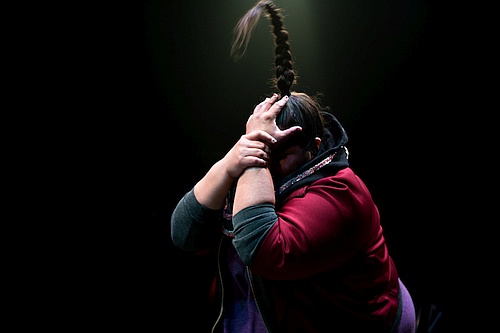 bug is ” one of the most important works of theatre you can see right now.”
bug is ” one of the most important works of theatre you can see right now.”
bug’s poetic exploration of intergenerational trauma, the oppressive tactics utilized by the settler colonialist state we call Canada, and internalized colonization could not be more timely.
bug pulls back the curtain on the falsehood of reconciliation using storytelling and movement, bringing everything we’ve seen in the news and the history books into the heart and gut. I felt a visceral and powerful connection with the performer and the audience throughout the performance.
bug’s intergenerational story is familiar from recent news about birth alert systems that exist throughout Canada. Birth alerts notify child protection agencies when a baby is born to a person deemed “high-risk,” including individuals who themselves were raised in child protective services. This means that multiple generations of a family have had children removed and placed in foster care. The system disproportionately affects Indigenous communities. In fact, there are so many Indigenous children in institutional care, that people have likened it to a continuation of the residential school system.
The one-hander, created and performed by Yolanda Bonnell and directed by Cole Alvis, is three interwoven monologues, punctuated by – and embellished with – sound and movement. Bonnell transitions seamlessly between the personae of The Girl, The Mother, and an ominous, mythical bug-creature – a manidoon.
Bonnell showed herself to be an unparalleled performer. She was absolutely riveting as all three characters and my empathy for The Girl and The Mother was total throughout. As The Girl, she was naïve and idealistic, romantic and hopeful. As The Mother, she was earthy and resilient, using humour as a coping strategy. As the manidoon, her voice and body language took on an otherworldly quality that embodied the legends that form the basis of the character.
The show is incredibly physical, requiring Bonnell to fall to the floor and rise lithely multiple times while illustrating the more poetic passages of The Girl’s monologues through sweeping and supple gestures. Bonnell has a superb command of movement-based storytelling and executes the choreography stunningly.
I feel the sound design is one of the most magnificent aspects of an intensely powerful piece. Surround sound accompanies the piece with Indigenous singing, electronic sounds, and very realistic bug noises. There were times when I saw audience members physically reacting as though there were bugs on their bodies.
A Q&A follows each performance. When an audience member asked Bonnell where she drew inspiration for the story from, she revealed the inspiration was stories she saw around her growing up. She also described a process where it was a though she was channeling The Mother through her as a distinct voice insisting on being heard.
While Bonnell draws the stories in the piece from particular forms of oppression faced by Indigenous communities, bug resonates with anyone who has lived under the systemic violence and marginalization of the kyriarchy. The piece’s final beat is one of hope and triumph over adversity. This show is definitely one of the most important works of theatre you can see right now.
Details:
- bug is playing until February 22, 2020 at Theatre Passe Muraille (16 Ryerson Avenue)
- Showtimes are 7:30 PM on February 13-15, & 18 -21, with an additional matinee at 2 PM on February 16, 2020.
- Tickets prices range from $17-38 (Under 30, $17; Arts worker, $25, Senior, $33, General Admission, $38). The performances on Feb. 16 & 19 are pay-what-you-can (PWYC). The performance on Feb. 15, 16 & 20 are relaxed performances
- Tickets are available online.
Photo of Yolanda Bonnell by Kaytee Dalton
